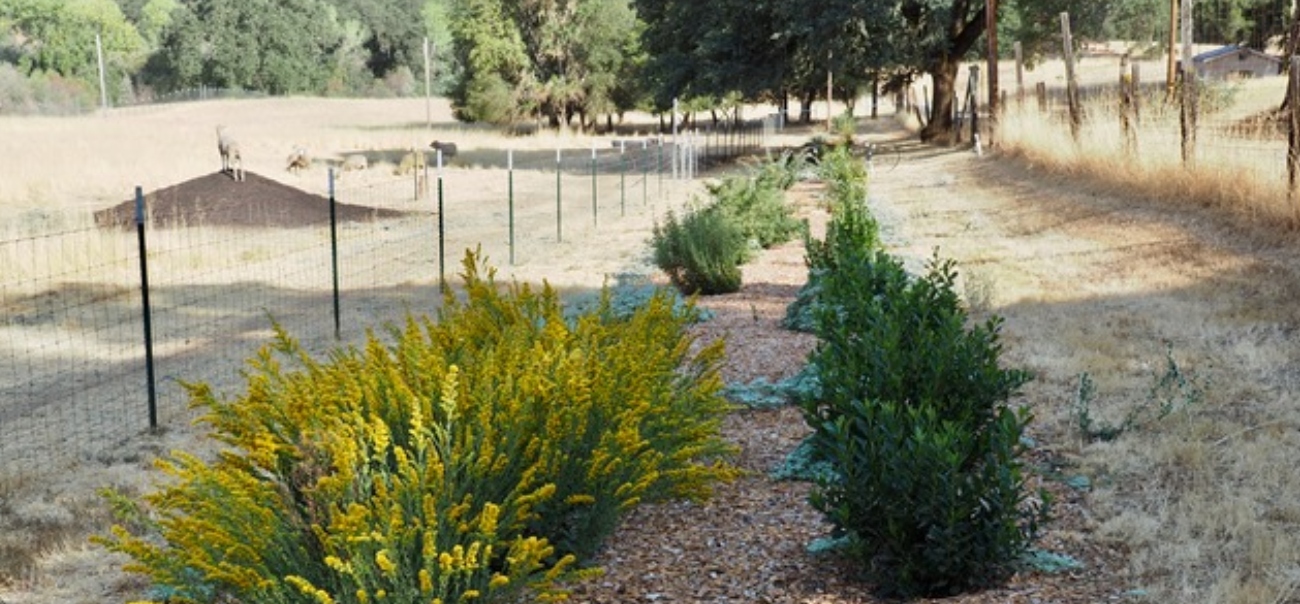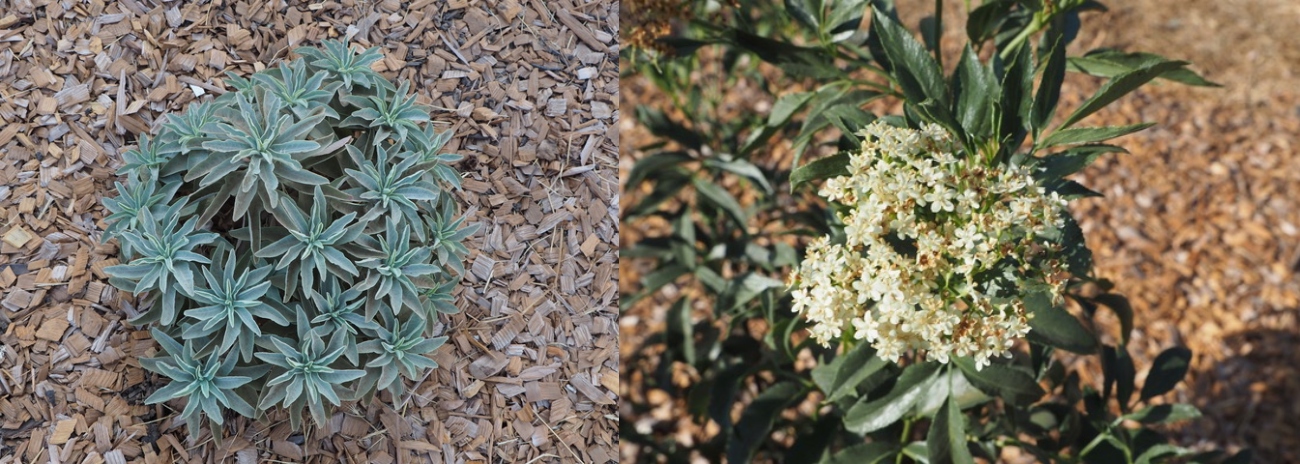Written and Photographed by Karen Rifkin
Before entering the fenced-in area of hedgerow plantings, a flock of friendly rams trot up, eagerly, to see if it’s feeding time. Realizing their exertion is for naught, they just as quickly disperse back into the field at the Hopland Research and Extension Center, a 5,358-acre working ranch and multi-disciplinary research and education facility situated in the foothills of the Mayacama Mountains, a rangeland of mostly rugged topography, run by the University of California’s Division of Agriculture and Natural Resources.
HREC’s director, John Bailey, who oversees the site and its many operations, explains that back in 1951 the site was purchased as a sheep center when there were about 10 times as many sheep as there are now in California.

“Over time, the center has evolved, along with the needs in the area, and today we do more work in wildlife ecology, diverse aspects of climate change, whether it’s soils or plants or wildlife interactions, fire ecology and fire science,” he says.
The sheep population has dwindled and the site now averages between 200 to 400 sheep; their focus is on outreach and education to those who are raising smaller flocks rather than large scale, multi-thousand flocks as they had done in the past when their own flock numbered over 1,000.
Entering the gate to the hedgerow, Bailey points to the first bed of plants—8 by 25 feet— those that thrive in the chaparral: Manzanita, sourced from the site; Yerba Santa; Coyote Bush; Great Valley Gumweed and Fremont Silk Tassel.
Moving along the 350 feet of California natives that were planted last fall, the next section, about 60 feet in length, is left bare.
“Since their roots don’t like summer irrigation, we created gaps in the hedgerow under the oak trees—the Valley Oak here and the Blue Oak further down,” he says.
Moving past the Valley Oak, we come upon a bed of dye plants— Toyon, Hairy Coffeyberry and Goldenrod, in its glory, the queen of the hedgerow, reaching out its plumes of fluffy yellow flowers.

Bailey explains that the hedgerow was funded by a California Department of Food and Agriculture Healthy Soils Program Demonstrations Project grant written in partnership with Fibershed to demonstrate the diversity of plant mixtures that can be put into a hedgerow, both for riparian habitats and chaparral, and to encourage people to adopt these projects and practices.
Its multiple goals include creating an environment for pollinator species and for wildlife, increasing biodiversity and sequestering carbon.
“By putting hedgerows back on the land, more carbon is sequestered into the soil,” he says. “These deeply-rooted perennial shrubs and trees gather carbon dioxide from the atmosphere, turn it into sugar through photosynthesis and exude the sugar from their roots into the ground. The carbon from the atmosphere is in those sugars.
“Scientists have discovered that as the sugars go into the ground, they feed the fungi and other life forms; in exchange the fungi digest the minerals in the soil and make them available to the plants in a form they can absorb.”

In preparation for the long bed, the area was mowed but not tilled; holes were augured and a small bit of compost was added to each; plants were put in; cardboard mulch was laid down; compost was applied and wood chips were placed on top to reduce evaporation.
Two circuits of drip lines were installed—some plants require less water than others—with individual one-gallon-per-minute emitters placed carefully to the side of the plant, not directly on top, so as not to induce crown rot.
“We’ll keep the drip lines for plants that need a bit more moisture going for a few more years and the drier plants will be watered only for the first year or two to help them get established. This year they all get watered weekly for about 4 to 5 hours and next year we will shut off the dry land ones, watering them one or two times during the summer,” he says.
Moving past the dye plants there is Chokecherry; Wavyleaf Silktassle, grown more commonly towards the coast; Honeysuckle and California Rose, sourced from the Russian River just a few miles away.

“We purchased many of these plants from Mendocino College because they were sourced locally. It keeps the genetic diversity limited to what really is adapted to this area as much as possible.”
There’s Coast Whitethorn, from northern Mendocino County; Buck Brush, a ceanothus from Hopland; California Buckeye and Pajaro Manzanita, specifically beneficial for insects and pollinators.
“If you want to create a physical barrier for your flock, Coast Whitethorn, with its hard spikey thorns, and Buck Brush, with its tough, toothy-edged leaves, would be a good combination,” he says.
The timers for the irrigation system are electric, run by a fully solar valve system set up on a post midway down the hedge.
Further on there is Hollyleaf Cherry; Purple, Black, White and Santa Rosa Island Sage, salvias beneficial for pollinator species; Sugar Bush; Globe Mallow; Bush Sunflower; Sticky Monkey Flower, a traditional remedy for poison oak; and California Grape sourced from the Russian River.

The final bed, past the Blue Oak, contains Narrow Leaf Milkweed, food for Monarch butterflies; Bush Sunflower; Mountain Lilac; Mountain Mahogany; Elderberry, another dye plant and a potentially marketable crop with its immune enhancing aspect, and Yarrow, traditionally used as a coagulant, chewed first before applying.
The tour complete and heading back to Bailey’s office, he explains HREC’s relationship with small-flock sheep farmers.
“We used to have a two-week shearing school here but when the state cut our budget a few years ago, we downsized and no longer had enough animals to fit the model for that school.
“Although there’s a certain market of people who just want to learn to shear, there’s an increasing number of people who have smaller flocks, who are generally early in their career and knowledge arc and require broader training.”

HREC worked with Fibershed, Hollenback Shearing and Rosie Busch, a ruminant specialist from UC Davis, to serve these smaller producers. They developed a curriculum for a one-week training on-site at HREC that would cover basic hoof care and general sheep health, management and shearing.
The in-person workshop was planned for 2020; COVID hit and they pivoted and refined their curriculum for an online training.
“The great thing about this was that people were able to attend from across the states; it was economically viable for them.”
The second year, they tweaked the curriculum a bit more and added in consulting hours for the participants—hour-long, follow-ups with an instructor.
Since the hedgerow project fit in with their goals of carbon farming and supporting smaller sheep producers, Bailey reached out to Fibershed and they agreed to offer support in writing the Healthy Soils Program grant.
He explains that the decrease in viability of sheep in California and around the world began in the ‘60s and ‘70s with the increase in production of microfiber and nylon that are made with petroleum products.
“Before that people used a lot more wool,” he says.
“When sheep graze the land, they eat the tops of the plants creating more root growth, helping to sequester more carbon in the soil. As the sheep eat, they make their wool so, in effect, you are using carbon dioxide from the atmosphere through the plant into the sheep to produce your wool.
“It’s a biodegradable fiber whereas with the increase in more microfleece and more petroleum-based materials, there’s an increase in plastic pollution; we’re finding microfibers from fleece in snowfall in the Arctic and in the oceans.
To support wool production, Fibershed is working towards a more viable livelihood for fiber producers by creating a bridge to textile manufacturers and the fashion industry, emphasizing the sustainability values of using wool instead of using hydrocarbon plastic-based clothing.
“Our sheep are bred for a mixture of wool and meat production and we don’t produce super high-quality wool; we grade and bale our wool primarily for large wholesale companies. There’s too much moisture here and we don’t have the climate; you can produce a lot finer wool in areas where winters are colder.

The other part of having sheep on the landscape, especially now, is for fire fuels reduction. There is more interest in having sheep do contract grazing—clearing out ladder fuels, lower growing plants that allow the fire to climb up to where it damages the trees—where they are brought in with portable electric fences and targeted for small-area grazing around buildings and sensitive areas.
“There were some really graphic examples of that here in Hopland when the fire came through in 2018. The oaks survived better on the land that was grazed and the fire was less severe where the sheep helped control some of the undergrowth.”
As HREC enters its 70th year, Bailey and his colleagues continue its legacy by working as stewards of the land to increase the diversity of the landscape, enrich the habitat for different species and maintain and enhance the integrity of the ecosystem through applied research, adaptive management and educational activities.

This project was supported by the ‘California Climate Investments’ program.
